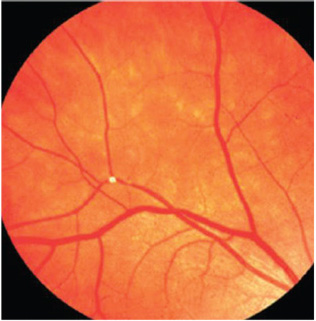 |
| Overall health burden and resulting impact on cardiometabolic health may be underlying contributors to an increased risk of retinal emboli in low-income individuals. Photo: Edward Chu, OD. Click images to enlarge. |
Associated with carotid artery disease and stroke, and subsequently a potential mark of underlying cardiovascular pathology, retinal emboli were studied by a group of researchers to estimate incidence in the US population based on data from the 2005 to 2008 National Health and Nutrition Examination Survey. The team also sought to identify factors associated with the development of the condition.
Included were 5,764 survey participants aged 40 years or older, with retinal emboli identified using retinal fundus photography. Analysis sought to determine there were any associations of the plaque-like lesions’ presence with age, sex, race/ethnicity, education, income, smoking, alcohol use, BMI, hypertension, diabetes hypercholesterolemia and cardiovascular disease history.
Incidental retinal emboli were seen in 0.7% of the study population, although an increase was seen with age. Prevalence was 0.1% in the age bracket of 40 to 49, which increased significantly to 1.4% in the bracket of 70 or older. While prevalence did not differ by sex or race, there were a few associated factors found after adjusting for age and sex, including an underweight BMI, current smoking, low household income and hypertension.
The study authors relate their findings to previous and similar research, stating that their results align with reports of the population-based studies of the Beaver Dam Eye Study and Blue Mountains Eye Study, along with more recent studies limited to certain ethnic groups.
The factors of age, hypertension and tobacco use have already been reported in literature to increase retinal emboli risk, but the novel factors identified in the present study of socioeconomic status and nutritional status are of interest. The study researchers hypothesize that “the increased health burden faced by socioeconomically disadvantaged individuals and the resulting impact on cardiometabolic health may contribute to the association between low household income and incidental retinal emboli.” Low BMI and general cardiovascular risk has previously been identified, causing the researchers to think that this may reflect additional risk factors of poor nutritional status and chronic medical conditions in an underweight population to exacerbate risk of retinal emboli.
Although these newly identified risk factors may help clinicians better watch out for those at risk, the authors still note that “further investigation into the potential association of socioeconomic and nutritional status with retinal emboli may enable opportunities to identify individuals with underlying cardiovascular risk.”
Teebagy S, Jastrzembski BG, Oke I. Factors associated with incidental retinal emboli in the US adult population. Am J Ophthalmol. August 13, 2023. [Epub ahead of print]. |


